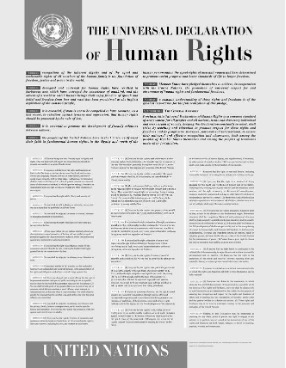Since the 1960s, we have witnessed an upheaval in the moral order and the concept of human rights in a secularized Europe that has rejected its Christian roots. The result is that human rights have changed radically since the Universal Declaration of 1948.
“Whereas the human rights of 1948 reflected natural rights, the affirmation of individualismhas generated new, anti-natural rights”.[1]
How did this happen?
The human rights at the beginning
Following the horrors of the Second World War, the European countries, together with other nations, established a new world order based on national and international control systems designed to protect human beings from the excesses of the State. The aim was to strengthen human rights at supranational level, and to make respect for these fundamental rights binding on states.


The root of the problem
A few personalities – notably the Lebanese Christian Charles Malik, rapporteur of the Commission responsible for drafting the 1948 Universal Declaration of Human Rights, and Pope Pius XII – did their utmost to ensure that human rights be linked to the divine law, or at least to man’s natural and sacred rights. But they were not listened to. None of the texts enshrining human rights – the 1948 Universal Declaration, the 1950 European Convention on Human Rights, the 2000 Charter of Fundamental Rights of the European Union – refers to a transcendent morality, even if the drafting of these texts was influenced by Christianism. Pope Pius XII had warned the drafters of the 1950 Convention in the following terms:
“If Europe is to emerge from this situation, must it not re-establish the link between religion and civilization? […] (Without) the express recognition of the rights of God and His law, or at least of Natural Law, the solid foundation on which human rights are anchored, […] how can these rights and all freedoms ensure unity, order and peace?”[ii]
The progressive shift
By detaching European values from any transcendent truth, didn’t the authors of Europe’s founding texts run the risk that these values “go mad and wander alone”, as the famous English writer Gilbert Keith Chesterton warned us at the beginning of the 20th century?This is the progressive, inexorable drift that we have been witnessing for over fifty years. It is the absence of a transcendent justice that has paved the way for the perversion of human rights into individual rights: the right to self-determination, the right to live the life of one’s choice, the right to control one’s own body leading to the right to change sex and to abort, the”right to die with dignity”, which in practice means euthanasia. All these rights are based on the idea that each individual is the source of his own values, and on the refusal to acknowledge that God has set limits for mankind for the sake of man’s good and happiness.
The mechanisms of the drift
The European Court of Human Rights (ECHR), also known as Strasbourg Court, is the guarantor of respect of human rights by the member states of the Council of Europe. Since its creation, ECHR has often been effective in protecting the “inalienable and sacred” natural rights of individuals against abuses by the state.
However, not being firmly anchored in a higher moral reference, fundamental rights began to drift with the decisions of the judges sitting in the supreme court. These judges not only ensure that fundamental rights are respected, but they have also granted themselves the power to define the content of these rights and make them evolve. “The European Convention on Human Rights is a living instrument, to be interpreted in the light of current living conditions”, reads aCouncil of Europe publication[iii]. Thus, under the impetus of the ECHR, the moral order has progressively evolved into a “reversed moral order”. Why reversed? Because, whereas for more than a thousand years of European history, the moral order emanated from a transcendent truth from above, since the second half of the 20th century, a new morality has gradually been established, coming from below, determined by individuals claiming new rights. These new types of individual rights, through the mechanism of creating case law generated by appeals to the supreme courts, are entering the ‘temple of human rights’, whose guardian is the Strasbourg Court, which in 2010 proclaimed itself the Conscience of Europe.[iv]
This article is based on Pellet’s article Evolution of the Right to Life, in European Mirror, XXV. évfolyam (2022)1-2. szám p 189-205 – and on Pellet’s book L’ordre moral renversé, published by L’Harmattan in June 2023
[i] PUPPINCK Grégor, Les droits de l’homme dénaturé, Éditions du Cerf, p. 11.
[ii] Address given by Pope Pius XII to participants at the Congress of the Union of European Federalists
(11 November 1948). Documents Pontificaux 1948. 403–407
[iii] The European Convention on Human Rights, a living instrument, published by the Council of Europe, European Court of HumanRights, August 2021, p. 7.
[iv] ECHR (2004): Report titled The Conscience of Europe. 50 Years of the European Court of Human Rights.
Photo credit: Hieronymus Bosch, The Garden of Earthly Delights, source: Wikipedia






